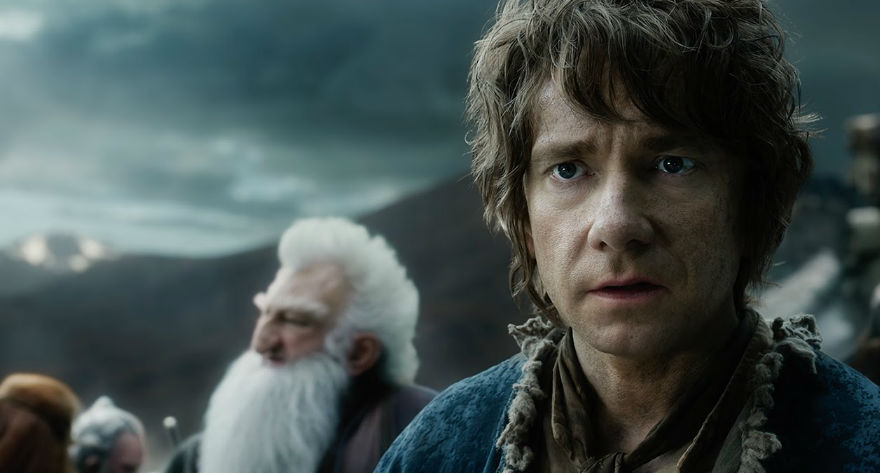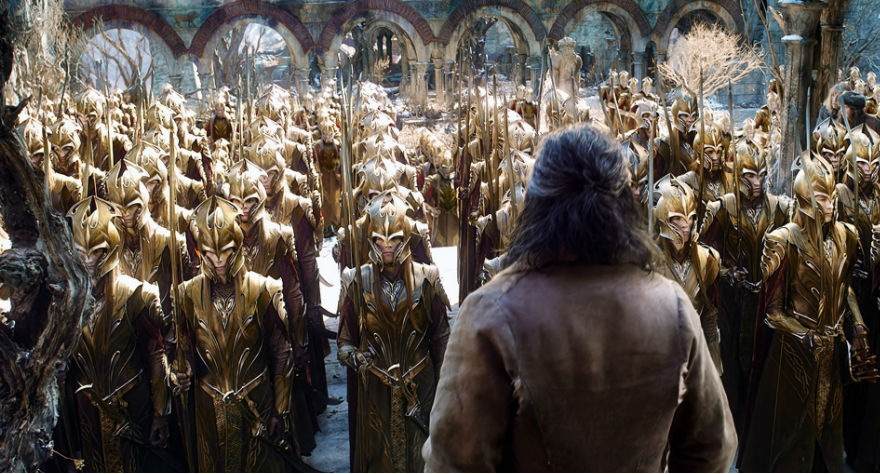
Peter Jackson's Middle Earth hexalogy ends with a mildly entertaining, mindless battle royale.

Peter Jackson's Middle Earth hexalogy ends with a mildly entertaining, mindless battle royale.
After two movies worth of Bilbo Baggins (Martin Freeman) and his stubby dwarf friends trudging across Middle Earth to the lair of the fearsome dragon Smaug, Peter Jackson’s distended Hobbit prequels come to an end with The Hobbit: The Battle of the Five Armies, an action-packed last hurrah that sadly feels too reiterative and scattershot to chalk up the trilogy as anything but unworthy. Those who (understandably) come expecting a massive battle royale between hoards of dwarves, elves, men, and orcs will no doubt be satisfied, but those of us less inclined to settle for mindless decapitation, long battlefield camera swoops, and Orlando Bloom surfing on random objects will feel underwhelmed by the film’s lack of emotional depth.
Five Armies opens on a rousing note, with what could have (or should have) been The Hobbit: The Desolation of Smaug‘s climax: the vain, malevolent dragon Smaug (voiced by Benedict Cumberbatch, whose voice booms out of the speakers like thunder) torches the village of Lake-town, whose ill-equipped denizens have been dreading his arrival, with fiery vengeance (and breath), threatening to reduce every inch of the seaside locale to ashes and embers. Smaug is a remarkable achievement in digital effects, almost on par with Gollum. After raining hellfire and brimstone on the poor villagers, a heroic family man and archer (Luke Evans) manages to best the beast in a one-on-one showdown. From here the film sadly takes a permanent dip.
The charismatic Smaug’s end is a fitting one (it’s the film’s most exciting sequence by far) but with him out of the picture, it leaves us without a lead villain. Dwarf leader Thorin Oakenshield (Richard Armitage) takes up the “Big Bad” throne, as he rescinds his promise to share the dragon’s treasure (whose dark properties seem to have corrupted him) with the survivors of the Lake-town attack, who desperately need the gold to rebuild what’s left of the village. They helped him get to the Lonely Mountain in the first place, after all.
The elven army, led by Thranduil (Lee Pace), shows up to claim a piece of the treasure, too, but Thorin’s having none of it, ordering his handful of loyal dwarf warriors to barricade the doors and calling for reinforcements from back home to fight the men and elf armies off for him. Then, a hoard of Orcs (and later, an army of…bats, or something; it isn’t really clear) shows up to crank the intensity up to eleven. It’s a massive, all-out skirmish for the rest of the film, and if you’ve seen The Lord of the Rings: The Return of the King, you’ll probably be hit with a big whiff of deja vu at this point.

It’s hard not to get caught up in all the sword clashing, giant military formations, grunting orcs and dwarfs (the elves don’t grunt as much), and other battle scene ridiculousness, especially if the thought of arranging five buckets of army men on your living room floor on Christmas morning and then smashing them all to hell in your pajamas still sounds fun to you. I’m still a kid at heart, so how could I resist a good melee? I can’t deny that I had a good bit of fun. The problem here is, it all feels very much like the open-field battle scene at the end of The Return of the King, and has inherited most of the same problems: it’s frantic, hard to follow (there are too many protagonists to keep track of), and way, way too long. It’s all so overblown that the (halfway decent) character work that builds up to the war almost feels like a means to an end, a 90-minute excuse to show you giant CGI orcs toppling over onto CGI warthogs.
There’s another issue I’ve had with Jackson’s Hobbit movies that’s as rampant as ever in Five Armies. The way Jackson films deaths, specifically when the good guys kill the bad guys, is so over-sensationalized and exploitative that at some points it feels as mind-numbing one of the Saw films. An orc vaults up toward Legolas, who’s standing on a higher platform in Lake-town. He uses his two short swords like scissors to behead the baddy and lets the severed head rest on his blades as the rest of the carcass falls to the water. I can understand how this can come off as pretty cool to some people, but to me, kills like this feel a little…trashy.
The Hobbit movies sure do look and feel like their Lord of the Rings big brothers, but there’s something off about them. It’s the little things: while some the original trilogy’s scenes glow with a majestic golden hue (like the ones in Rivendell), Hobbit‘s golden hues look more piss-yellow. (Gross, I know, but watch the films and tell me I’m wrong. Looks like piss.) But the larger issue here is that Hobbit‘s heroes and their plights aren’t all that compelling. Ian McKellen looks tired as hell in his sixth series outing as Gandalf; Freeman, who’s barely in the movie, can’t touch Elijah Wood’s brilliant turn as Frodo; Evangeline Lilly’s elf-lady has a crush on a dwarf that ends awkwardly; and Bloom’s just thrown in there to look pretty and perform unnecessarily acrobatic mass murder.
Five Armies‘ saving grace is Thorin, whose inner-struggle with his lust for power and gold is delivered incredibly well by Armitage. What bigger villain is there than greed itself? The war at the foot of the Lonely Mountain is nothing compared to the war going on inside Thorin’s mind and soul. It’s a great, intimate story told by a fine actor, but it unfortunately gets drowned out by all the noise.